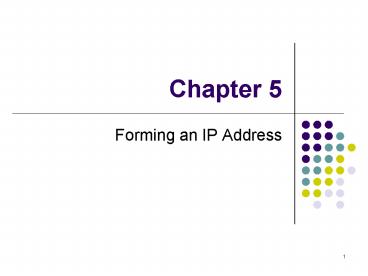Forming an IP Address - PowerPoint PPT Presentation
1 / 20
Title: Forming an IP Address
1
Chapter 5
- Forming an IP Address
2
IPv4
- Version of IP used on the Internet today
- Classes A, B, and C are the only ones in use.
- Classes D and E are reserved for multicasting
research.
3
IPv4 Subnetting
- Process of shifting the network part of an IP
address into the node share - Creates more logical network addresses with fewer
hosts per network - Makes it possible to subdivide network address so
that it is a better match to the physical network - Supernetting is the opposite
4
Classless InterDomain Routing (CIDR)
- Used in most networking equipment today
- Possible to use all ones and all zeros as subnet
addresses - Gives the ability to shift the boundary between
network and host by a single bit and create two
subnets as result
5
IPv6
- Designed to overcome limitations of IPv4
- 128 bit address length
- Divided into 8 16-bit sections which are
converted into 4-digit hexadecimal numbers
separated by colons - Example 402A00002F7C000108BBFFE3728D095A
- Leading zeros can be left off 402A02F7C18BBF
FE3728D95A
6
Default Gateways
- IP address of a router that is designated for any
traffic for which the route is unknown - On a computer connected to an internetwork, the
default gateway is the IP address of a router on
that computers segment. - On a computer connected to the Internet through
an ISP, the default gateway is the Internet
Service Providers router IP address, which is
used for all Internet-bound traffic
7
Default Gateway
8
Default Gateway
9
Public and Private IP Networks
- A public IP network address is directly connected
to the Internet. - A private IP network address is used by networks
that are either completely disconnected from the
Internet or that use network address translation
(NAT) to increase the number of IP addresses
available on the internal network.
10
Public and Private IP Networks
- Three private IP addresses are available, one for
each class of IP address. - The private class A network address is
10.0.0.0/8. - The private class B network address is
172.16.0.0/12 - The private class C network address is
192.168.0.0/16. - Must be disconnected from the Internet or hidden
behind a NAT or proxy server.
11
Public and Private IP Networks
- NAT is used to translate IP addresses from one
network and map them to a different IP address
known within another network. - The private IP address is used on the network
that is designated as internal, and it is mapped
to a public IP address used on the public
Internet.
12
TCP/IP Protocol Functions
- Application
- Application-layer services in the TCP/IP model
encompass the application, presentation, and
session layers in the OSI reference model. - These protocols provide the primary data for a
network administrator, and are the ones users
will be most likely to interface with.
13
Application LevelTCP/IP Protocol Functions
- Telnet
- FTP
- TFTP
- HTTP
- HTTPS
- POP3/IMAP4
- SMTP
- NTP
- SNMP
Pages 131-139
14
Transport LevelTCP/IP Protocol Functions
- TCP
- UDP
Pages 139-140
15
Network LevelTCP/IP Protocol Functions
- ARP
- ICMP (ping)
- IP
Pages 141-142
16
Well-Known TCP and UDP Ports
17
Naming and Addressing
- DHCP
- Dynamic Host Configuration Protocol provides IP
addresses to network computers without an
administrator manually assigning them. - DHCP lets network administrators establish a
central DHCP server and configure it to deliver
IP addresses to DHCP clients.
18
Naming and Addressing
- DNS
- The Domain Name System provides for a
hierarchical naming system of computers on the
Internet. - Domain names are used to locate the DNS servers
in a hierarchical fashion. - A DNS server will forward a request to servers
either directly above or below themselves in the
hierarchy when they do not contain a listing for
a particular domain name to IP address.
19
DNS
20
Naming and Addressing
- WINS
- Windows Internet Naming Service is used on
networks that have NetBIOS names. - Windows servers are placed on the network to
maintain mappings of all IP addresses and NetBIOS
names. - WINS clients use a WINS server address to look up
NetBIOS names.































